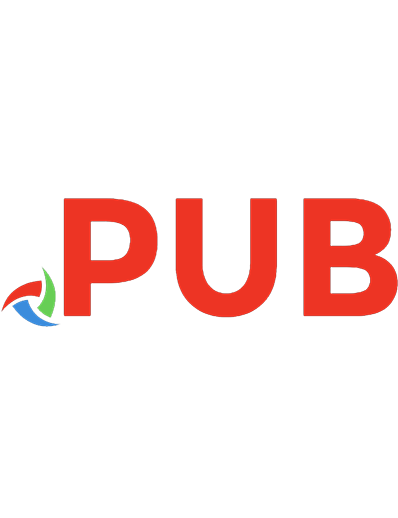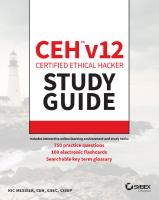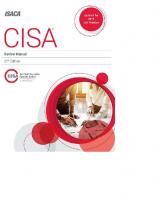CISA – Certified Information Systems Auditor Study Guide: Achieve CISA certification with practical examples and over 850 exam-oriented practice questions, 2nd Edition 1803248157, 9781803248158
Master the practical aspects of information systems auditing to pass the CISA exam and accelerate your career. Purchase
695 252 36MB
English Pages 330
Table of contents :
Cover
FM
Copyright
Contributors
Table of Contents
Preface
Chapter 1: Audit Planning
The Contents of an Audit Charter
Key Aspects from the CISA Exam Perspective
Audit Planning
Benefits of Audit Planning
Selection Criteria
Reviewing Audit Planning
Individual Audit Assignments
Key Aspects from the CISA Exam Perspective
Business Process Applications and Controls
E-Commerce
Electronic Data Interchange (EDI)
Point of Sale (POS)
Electronic Banking
Electronic Funds Transfer (EFT)
Image Processing
Artificial Intelligence and Expert Systems
Key Aspects from the CISA Exam Perspective
Types of Controls
Preventive Controls
Detective Controls
Corrective Controls
Deterrent Controls
The Difference between Preventive and Deterrent Controls
Compensating Controls
Control Objectives
Control Measures
Key Aspects from the CISA Exam Perspective
Risk-Based Audit Planning
What Is Risk?
Understanding Vulnerability and Threats
Understanding Inherent Risk and Residual Risk
Advantages of Risk-Based Audit Planning
Audit Risk
Risk-Based Auditing Approach
Risk Assessments
Risk Response Methodology
Top-Down and Bottom-Up Approaches to Policy Development
Key Aspects from the CISA Exam Perspective
Types of Audits and Assessments
Summary
Chapter Review Questions
Chapter 2: Audit Execution
Audit Project Management
Audit Objectives
Audit Phases
Fraud, Irregularities, and Illegal Acts
Key Aspects from the CISA Exam Perspective
Sampling Methodology
Sampling Types
Sampling Risk
Other Sampling Terms
Compliance versus Substantive Testing
Key Aspects from the CISA Exam Perspective
Audit Evidence Collection Techniques
Reliability of Evidence
Evidence-Gathering Techniques
Key Aspects from the CISA Exam Perspective
Data Analytics
Examples of the Effective Use of Data Analytics
CAATs
Examples of the Effective Use of CAAT Tools
Precautions while Using CAAT
Continuous Auditing and Monitoring
Continuous Auditing Techniques
Key Aspects from the CISA Exam Perspective
Reporting and Communication Techniques
Exit Interview
Audit Reporting
Audit Report Objectives
Audit Report Structure
Follow-Up Activities
Key Aspects from the CISA Exam Perspective
Control Self-Assessment
Objectives of CSA
Benefits of CSA
Precautions while Implementing CSA
An IS Auditor’s Role in CSA
Key Aspects from the CISA Exam Perspective
Summary
Chapter Review Questions
Chapter 3: IT Governance
Enterprise Governance of IT (EGIT)
EGIT Processes
The Differences between Governance and Management
EGIT Good Practices
Effective Information Security Governance
EGIT – Success Factors
Key Aspects from the CISA Exam Perspective
IT-Related Frameworks
IT Standards, Policies, and Procedures
Policies
Standards
Procedures
Guidelines
Information Security Policy
Key Aspects from the CISA Exam Perspective
Organizational Structure
Relationship between the IT Strategy Committee and the IT Steering Committee
Differences between the IT Strategy Committee and the IT Steering Committee
Key Aspects from the CISA Exam Perspective
Enterprise Architecture
Enterprise Security Architecture
Key Aspects from the CISA Exam Perspective
Enterprise Risk Management
Risk Management Process Steps
Risk Analysis Methods
Risk Treatment
Key Aspects from the CISA Exam Perspective
Maturity Model
Laws, Regulations, and Industry Standards Affecting the Organization
An IS Auditor’s Role in Determining Adherence to Laws and Regulations
Key Aspects from the CISA Exam Perspective
Summary
Chapter Review Questions
Chapter 4: IT Management
IT Resource Management
Human Resource Management
IT Management Practices
Financial Management Practices
Key Aspects from the CISA Exam Perspective
IT Service Provider Acquisition and Management
Evaluation Criteria for Outsourcing
Steps for Outsourcing
Outsourcing – Risk Reduction Options
Provisions for Outsourcing Contracts
Role of IS Auditors in Monitoring Outsourced Activities
Globalization of IT Functions
Outsourcing and Third-Party Audit Reports
Monitoring and Review of Third-Party Services
Key Aspects from the CISA Exam Perspective
IT Performance Monitoring and Reporting
Development of Performance Metrics
Effectiveness of Performance Metrics
Tools and Techniques
Key Aspects from the CISA Exam Perspective
Quality Assurance and Quality Management in IT
Quality Assurance
Quality Management
Key Aspects from the CISA Exam Perspective
Summary
Chapter Review Questions
Chapter 5: Information Systems Acquisition and Development
Project Management Structure
Project Roles and Responsibilities
Project Objectives, OBS, and WBS
Key Aspects from the CISA Exam Perspective
Business Case and Feasibility Analysis
Business Cases
Feasibility Analysis
The IS Auditor’s Role in Business Case Development
System Development Methodologies
SDLC Models
SDLC phases
Software Development Methods
Software Reengineering and Reverse Engineering
Key Aspects from the CISA Exam Perspective
Control Identification and Design
Check Digits
Parity Bits
Checksums
Forward Error Control
Data Integrity Principles
Decision Support Systems
Decision Trees
Key Aspects from the CISA Exam Perspective
Summary
Chapter Review Questions
Chapter 6: Information Systems Implementation
Testing Methodology
Unit Testing
Integration Testing
System Testing
Testing Approach
Testing Phases
Key Aspects from the CISA Exam Perspective
System Migration
Parallel Changeover
Phased Changeover
Abrupt Changeover
Key Aspects from the CISA Exam Perspective
Post-Implementation Review
Key Aspects from the CISA Exam Perspective
Summary
Chapter Review Questions
Chapter 7: Information Systems Operations
Understanding Common Technology Components
The Types of Servers
Universal Serial Bus
Radio Frequency Identification
IT Asset Management
Performance Reports
Job Scheduling
End User Computing
System Performance Management
Nucleus (Kernel) Functions
Utility Programs
Parameter Setting for the Operating System
Registry
Activity Logging
Software Licensing Issues
Source Code Management
Capacity Management
Key Aspects from a CISA Exam Perspective
Problem and Incident Management
Network Management Tools
Key Aspects from a CISA Exam Perspective
Change Management, Configuration Management, and Patch Management
Change Management Process
Patch Management
Configuration Management
Emergency Change Management
Backout Process
The Effectiveness of a Change Management Process
Key Aspects from a CISA Exam Perspective
IT Service-Level Management
Evaluating the Database Management Process
Advantages of Database Management
Database Structures
Key Aspects from a CISA Exam Perspective
Summary
Chapter Review Questions
Chapter 8: Business Resilience
Business Impact Analysis
Key Aspects from the Perspective of the CISA Exam
Data Backup and Restoration
Types of Backup Strategy
Storage Capacity for Each Backup Scheme
Key Aspects from the Perspective of the CISA Exam
System Resiliency
Application Resiliency – Clustering
Telecommunication Network Resiliency
Business Continuity Plan
Steps of the BCP Life Cycle
Contents of the BCP
Backup Procedure for Critical Operations
The Involvement of Process Owners in the BCP
BCP and Risk Assessments
Testing the BCP
Key Aspects from the Perspective of the CISA Exam
Disaster Recovery Plan
The BCP versus the DRP
Key Aspects from the CISA Exam Perspective
DRP – Test Methods
Checklist Review
Structured Walkthrough
Tabletop Test
Simulation Test
Parallel Test
Full Interruption Test
Key Aspects from the CISA Exam Perspective
Recovery Time Objective (RTO) and Recovery Point Objective (RPO)
RPO
RTO and RPO for Critical Systems
RTO and RPO and Maintenance Costs
RTO, RPO, and Disaster Tolerance
Key Aspects from the CISA Exam Perspective
Alternate Recovery Sites
Mirrored Site
Hot Site
Warm Site
Cold Site
Mobile Site
Reciprocal Agreement
Summary
Summary
Chapter Review Questions
Chapter 9: Information Asset Security and Control
Information Asset Security Frameworks, Standards, and Guidelines
Auditing the Information Security Management Framework
Key Aspects from the CISA Exam Perspective
Privacy Principles
Physical Access and Environmental Controls
Environmental Controls
Alarm Controls
Water and Smoke Detectors
Fire Suppression Systems
Physical Access Control
Key Aspects from the CISA Exam Perspective
Identity and Access Management
Access Control Categories
Default Deny Policy – Allow All Policy
Degaussing (Demagnetizing)
Naming Convention
Single Sign-On
Key Aspects from the CISA Exam Perspective
Biometrics
Biometrics Accuracy Measure
Control over the Biometric Process
Types of Biometric Attacks
Summary
Chapter Review Questions
Chapter 10: Network Security and Control
Network and Endpoint Devices
Open System Interconnection (OSI) Layers
Networking Devices
Network Devices and the OSI Layer
Network Physical Media
Identifying the Risks of Physical Network Media
Network Protocols
Key Aspects from the CISA Exam Perspective
Firewall Types and Implementation
Types of Firewalls
What is a Bastion Host?
What is a Proxy?
Types of Firewall Implementation
The Firewall and the Corresponding OSI layer
Key Aspects from the CISA Exam Perspective
VPN
Types of VPN
VPNs – security risks
VPNs – Technical Aspects
Key Aspects from the Perspective of the CISA Exam
Voice over Internet Protocol (VoIP)
Key Aspects from the CISA Exam Perspective
Wireless Networks
Enabling MAC Filtering
Enabling Encryption
Disabling a Service Set Identifier (SSID)
Disabling DHCP
Common Attack Methods and Techniques for a Wireless Network
Key Aspects from the CISA Exam Perspective
Email Security
Key Aspects from the CISA Exam Perspective
Summary
Chapter Review Questions
Chapter 11: Public Key Cryptography and Other Emerging Technologies
Public Key Cryptography
Symmetric Encryption versus Asymmetric Encryption
Encryption Keys
The Hash of the Message
Combining Symmetric and Asymmetric Methods
Key Aspects from the CISA Exam Perspective
Elements of PKI
PKI Terminology
Processes Involved in PKI
Certifying Authority versus Registration Authority
Key Aspects from the CISA Exam Perspective
Cloud Computing
Cloud Computing – Deployment Models
Types of Cloud Services
Cloud Computing – the IS Auditor’s Role
Virtualization
Mobile Computing
Internet of Things (IoT)
Summary
Chapter Review Questions
Chapter 12: Security Event Management
Security Awareness Training and Programs
Participants
Security Awareness Methods
Social Engineering Attacks
Evaluating the Effectiveness of Security Programs
Key Aspects from the CISA Exam Perspective
Information System Attack Methods and Techniques
Malicious Code
Biometric Attacks
Key Aspects from the CISA Exam Perspective
Security Testing Tools and Techniques
General Security Controls
Network Penetration Tests
Key Aspects from the CISA Exam Perspective
Security Monitoring Tools and Techniques
IDS
IPS
Honeypots and Honey Nets
Key Aspects from the CISA Exam Perspective
Incident Response Management
Computer Security Incident Response Team
Key Aspects from the CISA Exam Perspective
Evidence Collection and Forensics
Chain of Custody
Key Elements of Computer Forensics
Summary
Chapter Review Questions
Index
Other Books You May Enjoy


![CISA – Certified Information Systems Auditor Study Guide: Achieve CISA certification with practical examples, 2nd Edition [2 ed.]
9781803248158](https://dokumen.pub/img/200x200/cisa-certified-information-systems-auditor-study-guide-achieve-cisa-certification-with-practical-examples-2nd-edition-2nbsped-9781803248158.jpg)





![(ISC)² SSCP Systems Security Certified Practitioner Official Study Guide, Second Edition [2nd ed.]
9781119542940](https://dokumen.pub/img/200x200/isc-sscp-systems-security-certified-practitioner-official-study-guide-second-edition-2ndnbsped-9781119542940.jpg)

![(ISC)2 CISSP Certified Information Systems Security Professional Official Study Guide [9 ed.]
1119786231, 9781119786238](https://dokumen.pub/img/200x200/isc2-cissp-certified-information-systems-security-professional-official-study-guide-9nbsped-1119786231-9781119786238.jpg)